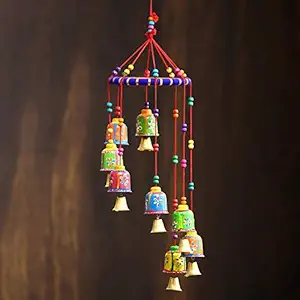હો રૂડે ગરબે રમે છે દેવી અંબિકા રે
હે પાય વાગે છે ઘૂઘરી ના ખમકા રે
હો રૂડે ગરબે રમે છે
હે બ્રમ્હલોક માંથી બ્રહ્મા જોવા આવિયા રે
હે સાથે દેવી બ્રમ્હાણી ને લાવીયા રે
હો રૂડે ગરબે રમે છે
હે વિષ્ણુલોક માંથી વિષ્ણુ જોવા આવિયા રે
હે સાથે દેવી લક્ષ્મીજી ને લાવીયા રે
હો રૂડે ગરબે રમે છે
હે કૈલાશ માંથી મહાદેવ જોવા આવિયા રે
હે સાથે દેવી પાર્વતીજી ને લાવીયા રે
હો રૂડે ગરબે રમે છે
હે નાગલોક માંથી નાગદેવ જોવા આવિયા રે
હે સાથે સર્વે નાગણીઓ ને લાવીયા રે
હો રૂડે ગરબે રમે છે
Overview of "Rude Garbe Rame Chhe"
Title & Meaning
'Rude Garbe Rame Chhe' is a traditional Gujarati Garba song performed during Navratri, reflecting devotion, celebration, and cultural heritage.
Artist & Recording Details
Performed by folk artists across Gujarat, with recordings capturing both live Garba energy and studio quality.
Genre & Occasion
Devotional Gujarati folk Garba, typically performed during Navratri, weddings, and festive community events.
Language & Dialect
Lyrics are in Gujarati, featuring local expressions and cultural idioms that resonate with traditional Garba audiences.
Popularity & Reach
Widely recognized in villages and cities, performed during community Garba nights with multiple live and recorded versions.
Lyrics Structure & Themes
Devotional Invocation
The song opens with invocation to Goddess Amba, inviting blessings, protection, and divine grace for all devotees.
Repetitive Chorus
Chorus lines are repeated to encourage group participation, create rhythm, and energize the dancers.
Imagery & Symbolism
Lyrics include imagery of colors, lights, and traditional rituals representing faith, joy, and the spirit of Navratri.
Community & Togetherness
Emphasizes unity and collective celebration, promoting shared cultural and devotional experiences.
Emotional Resonance
Lyrics inspire joy, devotion, and excitement, creating an uplifting atmosphere during Garba nights.
Musical & Performance Elements
Instrumentation & Rhythm
Traditional instruments such as dhol, dholak, and hand claps create lively and engaging rhythms for dancers.
Tempo & Dynamics
Starts with a moderate tempo, gradually increasing to match the enthusiasm and energy of performers.
Live vs Studio Renditions
Live performances feature audience interaction and extended verses; studio versions are polished, concise, and broadcast-ready.
Dance Cues & Movements
Lyrics guide dancers through claps, spins, and circular formations, synchronizing movement with rhythm.
Audience Participation
Encourages everyone to join in singing and dancing, creating an inclusive and festive environment.
Festival & Cultural Significance
Navratri Connection
A prominent Garba song for Navratri, enhancing the spiritual and cultural experience of the festival.
Spiritual Meaning
Reflects devotion, faith, and reverence for Goddess Amba, seeking her blessings for prosperity and protection.
Cultural Heritage
Represents Gujarati folk traditions and preserves the continuity of musical and dance heritage across generations.
Community Bonding
Fosters community engagement, bringing people together through shared celebration, singing, and dancing.
Joyful Celebration
Creates happiness, pride, and spiritual enthusiasm among participants, enriching the festive Garba experience.
How to Use & Share
Translations & Transliteration
Translations and transliterations help non-Gujarati speakers understand and connect with the song’s meaning.
Audio / Video Embeds
Include live Garba videos and audio recordings to engage users and provide an immersive experience.
Printable Lyrics & PDFs
Provide downloadable and printable PDFs of lyrics for personal, educational, or community use.
Performance & Dance Tips
Offer costume suggestions, dance steps, and tips for performing Garba effectively during festivals.
SEO & Social Media
Optimize with keywords like Gujarati Garba, Rude Garbe Rame Chhe, Navratri Garba; add social sharing options to increase visibility.
'Rude Garbe Rame Chhe' is a traditional Gujarati Garba song performed during Navratri, reflecting devotion, celebration, and cultural heritage.
Performed by folk artists across Gujarat, with recordings capturing both live Garba energy and studio quality.
Devotional Gujarati folk Garba, typically performed during Navratri, weddings, and festive community events.
Lyrics are in Gujarati, featuring local expressions and cultural idioms that resonate with traditional Garba audiences.
Widely recognized in villages and cities, performed during community Garba nights with multiple live and recorded versions.
The song opens with invocation to Goddess Amba, inviting blessings, protection, and divine grace for all devotees.
Chorus lines are repeated to encourage group participation, create rhythm, and energize the dancers.
Lyrics include imagery of colors, lights, and traditional rituals representing faith, joy, and the spirit of Navratri.
Emphasizes unity and collective celebration, promoting shared cultural and devotional experiences.
Lyrics inspire joy, devotion, and excitement, creating an uplifting atmosphere during Garba nights.
Traditional instruments such as dhol, dholak, and hand claps create lively and engaging rhythms for dancers.
Starts with a moderate tempo, gradually increasing to match the enthusiasm and energy of performers.
Live performances feature audience interaction and extended verses; studio versions are polished, concise, and broadcast-ready.
Lyrics guide dancers through claps, spins, and circular formations, synchronizing movement with rhythm.
Encourages everyone to join in singing and dancing, creating an inclusive and festive environment.
A prominent Garba song for Navratri, enhancing the spiritual and cultural experience of the festival.
Reflects devotion, faith, and reverence for Goddess Amba, seeking her blessings for prosperity and protection.
Represents Gujarati folk traditions and preserves the continuity of musical and dance heritage across generations.
Fosters community engagement, bringing people together through shared celebration, singing, and dancing.
Creates happiness, pride, and spiritual enthusiasm among participants, enriching the festive Garba experience.
Translations and transliterations help non-Gujarati speakers understand and connect with the song’s meaning.
Include live Garba videos and audio recordings to engage users and provide an immersive experience.
Provide downloadable and printable PDFs of lyrics for personal, educational, or community use.
Offer costume suggestions, dance steps, and tips for performing Garba effectively during festivals.
Optimize with keywords like Gujarati Garba, Rude Garbe Rame Chhe, Navratri Garba; add social sharing options to increase visibility.

चंदन हवन कप
Buy Now
ईक्राफ्टइंडिया मल्टीकलर हैंडक्राफ्टेड सजावटी खिड़की-दरवाज़ा दीवार लटकन घंटियाँ
Buy Now